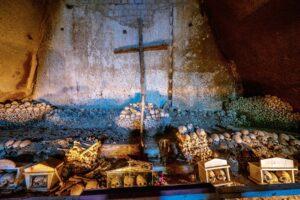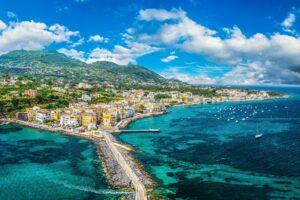Fodor's Expert Review San Giovanni a Carbonara
An engaging complex of Renaissance architecture and sculpture, this church is named for its location during medieval times near the city trash dump, where refuse was burned and carbonized. The church's history starts in 1339, when the Neapolitan nobleman Gualtiero Galeota donated a few houses and a vegetable garden to Augustinian monks who ministered to the poor neighborhood nearby.
San Giovanni's dramatic piperno-stone staircase, with its double run of elliptical stairs, was modeled after a 1707 design by Ferdinando Sanfelice similar to other organ-curved stairways in Rome, such as the Spanish Steps. Cross the courtyard to the left of the main entrance and enter the rectangular nave. The first thing you see is the monument to the Miroballo family, which is actually a chapel on the opposite wall, finished by Tommaso Malvito and his workshop in 1519 for the Marchese Bracigliano; the magnificent statues in the semicircular arch immediately set the tone for this surprising repository... READ MORE
An engaging complex of Renaissance architecture and sculpture, this church is named for its location during medieval times near the city trash dump, where refuse was burned and carbonized. The church's history starts in 1339, when the Neapolitan nobleman Gualtiero Galeota donated a few houses and a vegetable garden to Augustinian monks who ministered to the poor neighborhood nearby.
San Giovanni's dramatic piperno-stone staircase, with its double run of elliptical stairs, was modeled after a 1707 design by Ferdinando Sanfelice similar to other organ-curved stairways in Rome, such as the Spanish Steps. Cross the courtyard to the left of the main entrance and enter the rectangular nave. The first thing you see is the monument to the Miroballo family, which is actually a chapel on the opposite wall, finished by Tommaso Malvito and his workshop in 1519 for the Marchese Bracigliano; the magnificent statues in the semicircular arch immediately set the tone for this surprising repository of first-class Renaissance sculpture.
Dominating the skeletal main altar, which has been stripped of its 18th-century Baroque additions, is the 59-foot-tall funerary monument of King Ladislaus and Joan II, finished by Marco and Andrea da Firenze in 1428. A door underneath this monument leads to the Ser Caracciolo del Sole chapel, with its rare and beautiful original majolica pavement. The oldest produced in Italy, from a workshop in Campania, it shows the influence of Arab motifs and glazing technique.
The dating of the circular Caracciolo di Vico chapel, to the left of the altar, is the subject of debate. Usually given as 1517, with the sculptural decor complete by 1557, the design (often attributed to Tommaso Malvito) may go back to 1499 and thus precede the much more famous Tempietto in Rome, by Bramante, which it so resembles. Hanging to the right of the altar is the impressively restored 16th-century Crucifixion by Giorgio Vasari, and in the back chapel, some brightly colored frescoes by an anonymous 16th-century master, as well as an intriguing sculpture of a knight taking a nap in his armor. Because this great church is off the path of tour groups, you can absorb the ordered beauty of the decoration in peace.
READ LESS







